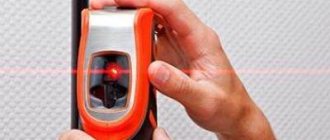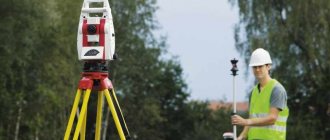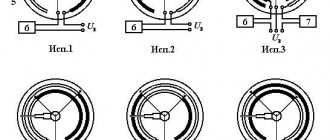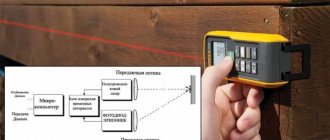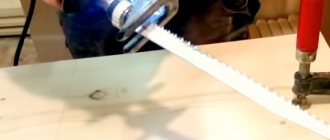- January 8, 2021
- Tools and equipment
- Larisa Mikhailova
The emergence of new electrical appliances makes life much easier and speeds up many production processes. To determine values indicating the distance to distant objects, a laser range finder is used. How to choose this device, which can be equipped with many additional operations and, accordingly, have a higher or lower cost? To avoid unnecessary financial costs, it is necessary to determine the purposes for which you plan to use this device.
The laser rangefinder is used both in everyday life and in scientific and professional activities. This device is in demand in areas such as construction, military affairs, and topographic surveys. Using a compact device, you can achieve measurement accuracy at relatively short and extremely large distances. The error of these devices is very low, ranging from 1.5 to 3 mm. But before you make a choice, you need to decide on the tasks that you plan to solve using this measuring device, since prices differ significantly depending on the functionality.
Pulse laser rangefinders
The first category is expensive and finds its application in industry. The operating principle of these devices is based on detecting objects by sending short pulses and receiving the reflected signal. Knowing the constant speed of light and the time it takes to reach an object, you can determine the length of the path to it.
Such devices have great power, so they are used to determine values in the range from one to hundreds of thousands of kilometers.
These instruments are used to find the location, determine the speed and orientation of objects in astronomical research, geodesy, shipping, and military operations.
Phase laser rangefinders
The second category of measuring laser devices operates on the basis of changing the parameters of the oscillation of the light flux after it is reflected from an object. Laser devices emit signals having a frequency of approximately 500 MHz. The reflected pulse is received by a photodetector. The length of the path to the object is determined by calculating the difference between the initial and final phases of the received signal.
These devices are used in everyday life and at work to determine short distances, no more than one kilometer. These are construction, robotics, geodetic calculations.
Phase rangefinders are used on construction sites in the form of a laser tape measure.
Specifications
In order to choose a laser rangefinder, like any other device, you need to pay attention to its parameters.
- One of the main characteristics is the measurement range. In many cases, it is necessary to determine distances of no more than 100 meters.
- The measurement accuracy determines the permissible error. It ranges from 1.5 to 3 mm.
- Laser rangefinders can be powered from AA or AAA batteries (“finger” or “pinky” batteries) or using a standard USB cable.
- The weight of laser measuring instruments does not exceed 150 grams.
- The degree of protection against dust and moisture is important for outdoor work when you have to deal with weather conditions. Indicated by: IP 54. The first number shows the degree of protection against dust, the second - against humidity. In this case we have average indicators. In light rain and some dust, the device will operate without failure. Just avoid being completely immersed in water or mud.
Dependence of technology on conditions
The rangefinder has two functional units: an emitter, which contains a laser diode, and a receiver. Due to the electromagnetic wave, a laser beam is generated. The wave itself is produced by the rangefinder, then it is reflected from the working plane, be it floors, walls, ceiling or another working side of the object. After this, it is returned to the receiver. Each wave has its own amplitude and length. The last indicator is initially known to the rangefinder calculator, so further calculations are made using the principle of adding all the wavelengths that have traveled to the object and back. After this, the given amount is divided in half. And if there is a “cut” wave, then its indicator is added.
Comparative characteristics of several laser rangefinder models.
The resulting figure is displayed on the device display. The measuring quantity, that is, meters or centimeters, is set according to personal requirements.
The rangefinder works well in closed spaces, since in this case the distances are small and there is no interference at all. As for nature, there are several factors that can create errors in work:
Sun. Often the color of lasers is red, so the brighter the surface, the less visible the end point
Why is this so important? Because the rangefinder must be able to process the signal, but it will be too weak, which can affect the accuracy of the readings. Therefore, in the dark, laser rangefinder readings are more accurate. Environmental pollution
The best option is if the work is carried out outside the city, since the air there is clearer. In conditions of gas or fog, again there is a risk of errors. Reliability of rangefinder mounting. Manual measurements are always accompanied by inaccuracies. Therefore, it is better to use a special tripod for measurements. By the way, many modern devices already have such an element as standard. Working surface. If the measured plane has a dark color or a rough structure, the beam will be absorbed. Therefore, for such purposes, a light surface is used, which, due to its smoothness and color, helps to increase the reflectivity.
Additional functions
- Display backlight - not found in all models. This function is necessary when working when there are bad weather conditions or the inability to get close to objects and structures, and therefore is an important parameter.
- Software for interacting with devices that have Bluetooth functionality for data transfer. This is necessary if you need to store a large amount of information. This feature allows you to work quickly and efficiently, saving time.
- The function of finding the area is available in many models. It makes it possible to do without a calculator. After measuring the length and width of the surface, the device independently calculates its area.
- The volume determination function is performed similarly to the previous one (the height is also measured in advance).
- Level - this function allows you to determine the deviation of the plane horizontally and vertically.
- Protractor - the ability to calculate the area of a triangle and its angles. In this case, three sides of the geometric figure are preliminarily measured. This function is good to use when you are dealing with non-standard rooms.
- Possibility of continuous measurement - the device works like a tape measure. To measure the distance, you need to move away from the desired object, and the device shows the distance. This feature ensures comfortable and efficient work. This device is called a laser tape measure.
- The ability to calculate parameters by measuring the angle of inclination ensures that values are calculated regardless of the presence of various obstacles between the object and the device. A laser rangefinder is used as a computing device. It must be directed to the highest point of the structure, then press the required function and get a calculation of the distance to it. This is done by measuring the length of the hypotenuse and the upper angle of the triangle.
- Many laser rangefinders allow you to make markings.
- Some models have a compass for determining directions.
- An interesting feature is the sound.
- Some devices allow you to find the maximum and minimum distance to an object.
- There is also a built-in so-called “painter function”. It measures and calculates the area of all walls in the room.
Once you have determined the features you need, you can think creatively about how to choose a laser rangefinder.
Types and principle of operation of the tool ↑
Despite the unifying concept of "rangefinder", each individual type calculates distance using different methods. Highlight:
- ultrasonic;
- phase laser;
- pulse laser;
- optic;
- optical filament types.
The roughest active type for measuring distance is an ultrasonic device. Its work is based on the principle of echo location, which is used even by some animals, for example, dolphins. The device creates a sound pulse and picks up an echo - sound waves that are reflected from an object.
For measurement accuracy, high frequency sound is used - 40 kHz. Since the speed of sound is known and the time it travels is easy to measure, all that remains is to calculate the distance, which is what an ultrasonic rangefinder does.
A simple model based on an ultrasonic sensor
If the same method is applied with a light pulse, the result is an accurate pulse-type laser rangefinder. The fact is that the speed of light is so high (300,000 km/s) that for small distances that are measured in construction (20, 30, 50 m), we are talking about fractions of nanoseconds. It is very difficult to measure time with such precision.
The main advantage of such a device is that it sends short pulses of light rather than a constant beam. This means that a high power laser can be used. Such a powerful impulse can easily “fly” back and forth over a distance of 100 km in a fraction of a second. This property is most often used in the military industry, and the device itself is much more expensive than its analogues.
How does a laser pulse work?
The operating principle of a phase-type laser rangefinder is based on comparing and determining the phase shift of a light wave. The device generates a light beam in the infrared spectrum. The beam moves at a known speed to the measurement target, is reflected and returns. The tool compares the phase of the light wave at the beginning of the movement and at the end. The measurement is taken twice, after which the device displays the result in meters.
One of the advantages of this type of distance meters is the price. They are much cheaper than pulse ones, because there is no need to equip a laser tape measure with an ultra-precise and expensive stopwatch. In addition, with the phase method the error is no more than half a phase, that is, less than a millimeter. This is an amazing result, but this device also has disadvantages.
Phase laser model
Since you have to shine not in short pulses, but constantly throughout the measurement, it will not be possible to install a powerful laser. This means that the device is not used over long distances. However, for construction purposes its range is more than enough.
Optical rangefinders are mainly used in geodesy, topographical work, navigation, and photography. It works according to the passive type, based on the Pythagorean theorem. The operating principle of such a device is difficult to describe with your fingers.
Military rangefinder
It is based on constructing an isosceles (for stereoscopic devices with two eyepieces) or right-angled (for monocular) triangle and mathematically calculating its height. The vertex of the triangle is the point to which the distance needs to be measured. Aiming is done manually.
In some rangefinders you need to compare two parts of the image for adjustment, in others you need to eliminate ghosting in the image. One way or another, the main sensor is the human eye, so error is inevitable.
Device diagram
A thread rangefinder is another optical device for measuring the distance to an object. It also works based on geometric calculations. To measure range, you need a special rangefinder rod - a long “ruler” with markings. The distance between the divisions is 2 cm. The rod is installed at the point to which the distance needs to be measured.
Thin threads are stretched inside the telescope. The rangefinder and the staff are set strictly level, so that the zero mark of both is at the same height. Next, the surveyor looks into the lens and counts how many 2 cm divisions are placed between the stretched threads. Thus, a triangle is constructed with the vertex at the focus of the instrument lenses.
The length of the height of this triangle + the focal length will be equal to the distance between the selected points. This type of rangefinder is often found in theodolites of different models.
What the surveyor sees through the peephole
ADA Cosmo MINI A00410 - laser tape measure
This is a compact device that has a minimum number of functions, but they are quite sufficient for measurements and calculations.
It is an excellent alternative to a regular tape measure and is suitable for finishing and carpentry work, and when installing windows. This is a compact and lightweight device that can be used both on a construction site and at home.
How to use indoors and outdoors - differences
The operation of the device outdoors and indoors is somewhat different. A rangefinder for outdoor use must be equipped with a reflective plate - a sight. To work on a sunny day, you cannot do without special red glasses. They will help detect the laser beam on a plane in bright daylight. An outdoor laser tape measure often has a durable casing specifically designed for outdoor use. The price of a rangefinder for indoors and outdoors varies slightly. The latter will cost a little more. Otherwise, the actions of the measuring instruments are identical.
The error of most budget rangefinder models is just 1-3 mm.
Several factors influence the incorrectness of the readings given and the increase in error:
- Design feature of the model
- Measurement range (the larger it is, the higher the error will be)
- Errors in operating the device
An electronic tape measure does not present any difficulty in operation. Turn on the device, press a button and observe the results on the display - it couldn’t be simpler. But there are still some rules that should be followed:
- During the measurement process, it is important that the rangefinder is stationary. This can be achieved using a tripod
- Monitor the battery charge level. Devices with a weak charge can negatively affect the results
- The object at which the laser beam is directed should not have high (mirror, foil) and low (plastic) reflectivity, otherwise the accuracy of the readings given will be in doubt
Bosch GLM 40 Professional 0.601.072.900
This is a good solution for professionals. The Bosch GLM 40 Professional laser rangefinder is very popular among representatives of the construction professions.
The device helps to measure length, calculate area, and calculate volume. It has a reliable shock-resistant case. The measurements taken are displayed on a 3-line backlit display. The model remembers the last 10 calculations.
Briefly about the main thing
Laser rangefinders are useful in solving a variety of application problems. The choice of a suitable model is made taking into account the scope and frequency of its use. This will determine which tool with what characteristics will be the best option.
The main characteristics of the device are range and measurement error. They are determined by the laser power; According to this parameter, laser devices are divided into three classes. Additional features may be useful for various purposes: number of reference points, ability to save results, tilt sensor, display backlight. The capabilities of standard household tools are sufficient for use indoors and on small plots of land.
Ratings 0
Laser rangefinder AEG LMG50 447680
The device provides a professional level of accuracy.
The main advantages of this model:
- operation in continuous measurement mode;
- ability to save up to 20 results in internal memory;
- auto-determination of the largest and smallest values.
The device is provided with a rubber casing.
Laser rangefinder ADA Cosmo 100
The device has an inclinometer function and measures distances in a range of 100 m. It has the following functions: addition/subtraction, area calculation, area addition/subtraction, volume calculation, indirect measurement. It has an automatic shut-off feature that activates after three minutes of inactivity. The service life is designed for 5000 or more measurements. The main advantages include:
- the ability to measure inaccessible segments;
- presence of a measurement timer;
- using three points as a reference point.
Laser rangefinder Leica Disto D110
The device has built-in Bluetooth Smart technology. Data from the laser rangefinder is transmitted to Android, Windows, iOS. Using the Leica Disto app (available free of charge), the Leica Disto D110 information allows you to create sketches, floor plans and other documents with precise measurement data.
The device has a convenient design with a pocket clip.
Laser rangefinder Bosch GLM 100 C
The device allows you to take measurements with an accuracy of 1.5 mm at any angle. Thanks to the 360° tilt sensor and control system, it is possible to measure distances, heights, widths and lengths of an object, as well as calculate its area and volume.
The measurement range of the Bosch GLM 100 C laser rangefinder is up to 100 meters. The accuracy of the device is 1.5 mm. The increased memory capacity allows up to 50 measurements.
The device is protected from dust and moisture: IP 54. This means that the dust resistance of the device is average (the first digit is 5), dust particles can get under the case, but nothing threatens the uninterrupted operation of the device. Number 4 indicates the degree of protection against moisture. Since this indicator is also close to the average, we can assume that working in the rain is acceptable, but complete immersion in water will lead to failure of the device.
The presence of basic free software allows you to connect devices with Bluetooth functionality for data transfer and storage.
The device weighs only 0.14 kg. The device is charged using a standard microUSB cable.
Terms of use
When working with such devices, certain rules must be followed. Thus, it is strictly unacceptable to direct the laser beam towards a person. Getting it into the eyes can lead to irreparable consequences, including loss of vision.
Taking measurements in bright sunlight can be difficult because the laser marker may be difficult to see. In this case, it is necessary to use special glasses through which it will be immediately visible.
Laser photography on location
When taking measurements outdoors, especially over long distances, it is necessary to use a plate called a visor.
